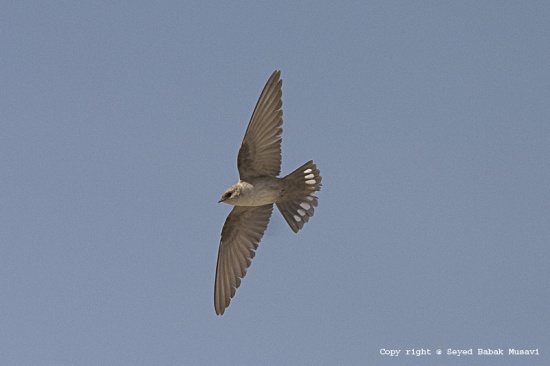- Ptyonoprogne fuligula
Hirundo fuligula
Identification
11-14 cm (4¼-5½ in)
- Earth-brown crown and upperparts
- Dark brown wings and tail
- Pinkish-cinnamon chin and throat
- Dark greyish-brown belly and undertail-coverts
Distribution
Taxonomy
Previously placed in genus Hirundo.
Subspecies
Thirteen subspecies are recognized[1]:
- P. f. presaharica
- South Morocco, Algeria (except south) and northern Mauritania
- P. f. spatzi
- P. f. buchanani
- South-central Sahara (Aïr Massif of northern Niger)
- P. f. obsoleta
- P. f. perpallida
- South Iraq and north-eastern Saudi Arabia
- P. f. pallida
- East Iran, southern Afghanistan and Pakistan
- P. f. arabica
- North East Chad, northern Sudan, south-western Arabia, Eritrea, northern Somalia and Socotra Island
- P. f. pusilla
- P. f. bansoensis
- Sierra Leone to Nigeria and Cameroon
- P. f. fusciventris
- Central and southern Chad, Central African Republic, western Sudan, South Sudan, and south-western Ethiopia south through East Africa to northern Mozambique
- P. f. anderssoni
- P. f. fuligula
- South Namibia, Botswana and western South Africa
- P. f. pretoriae
- South West Zimbabwe and southern Mozambique to eastern South Africa
Habitat
Rocky areas.
Behaviour
Breeding
The cup nest is constructed by both adults from mud pellets, lined with vegetable fibres and feathers. It is placed under an overhang on a rock face or similar man-made structure such as a dam, or bridge wall or under the eaves of a building.
The clutch consists of 2-3 eggs, which are white with black or chestnut spots. They are laid at 1 day intervals. Both adults incubate the eggs for 16-18 days. Fledging occurs after 22-29 days with the parents still tending to them for up to 19 days.
Diet
They forage in pairs, groups and mixed species flocks.. Their diet mostly consists of insects such as flies, beetles, bugs and flying ants.
References
- Clements, J. F., T. S. Schulenberg, M. J. Iliff, S. M. Billerman, T. A. Fredericks, B. L. Sullivan, and C. L. Wood. 2019. The eBird/Clements Checklist of Birds of the World: v2019. Downloaded from http://www.birds.cornell.edu/clementschecklist/download/
- del Hoyo, J., A. Turner, G. M. Kirwan, and N. Collar (2020). Rock Martin (Ptyonoprogne fuligula), version 1.0. In Birds of the World (S. M. Billerman, B. K. Keeney, P. G. Rodewald, and T. S. Schulenberg, Editors). Cornell Lab of Ornithology, Ithaca, NY, USA. https://doi.org/10.2173/bow.rocmar2.01
Recommended Citation
- BirdForum Opus contributors. (2024) Rock Martin. In: BirdForum, the forum for wild birds and birding. Retrieved 9 November 2024 from https://www.birdforum.net/opus/Rock_Martin
External Links
GSearch checked for 2020 platform.1




